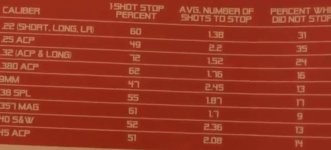I carry a .32 from time to time, without a bit of concern.
(The chart below is from a Greg Ellifritz article. Other studies have had similar findings.)
Look closely at that study. It uses bad methodology. Bad methodology or bad design leads to an inaccurate and invalid study and conclusion.
The author of that study, Gregg Ellifritz, is an amazing resource on defensive issues. He is a great teacher with a strong background in Law enforcement and training, and has written some of the best things that I have read on a wide variety of topics. I can appreciate the amount of time and effort he put into this. However, the theory and methodology behind the study is deeply flawed.
By his own description, the author of the study tried to record every shooting he could find. By definition this includes situations where an armed person shot an unarmed person, or shot someone who was not interested in fighting him in the first place, or not very serious about posing a threat. By his own admission the study includes victims shot by criminals. Unarmed victims who are terrified of their attacker are not a usable litmus. All of those fall into the heading of "every shooting he could find."
The author of the report "scoured the newspapers, magazines, and Internet for any reliable accounts of what happened to the human body when it was shot."
This is a huge problem because you often don't get accurate information about the gun or caliber used, number of shots fired or hit, where they hit, circumstances of the shooting, etc. You absolutely cannot include these accounts in any statistical study,
Further, even if the data were accurate, the premise of this study is flawed in the way it compares dissimilar shootings.
Shooting someone who isn't a serious attacker, who may not be armed, and is afraid of you isn't the same as shooting an of objective driven violent criminal attacker.
If you look at this author's logic, if two drunks at a bar get into a pushing match and one pulls out a .25 auto and shoots the other once and the man who was shot backs off, it counts as a one shot stop.
But if a police officer draws his 9mm loaded with Federal HST JHPs and as fires multiple quick shots at an attacker—in the manner in which he was likely trained--it counts as a one-shot failure, or a situation where multiple shots were required to stop someone.
I submit, would you rather rely on a .25 auto for self defense or the 9mm loaded with Federal HSTs?
I think it is admirable what the person who wrote this study tried to do, but I am afraid the methodology and theory wasn't there. I would not try to extrapolate any of his results on what would work for me if confronted by a violent criminal.

